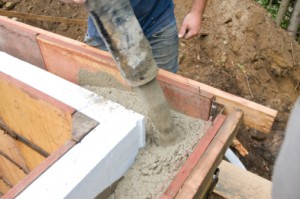Concrete Countertop Ideas: Bringing the Outside, In
June 10, 2013 9:21 amWhat does the world’s tallest building – the Burj Khalifa – have in common with the Roman Pantheon, Coliseum, Panama Canal, and the Hoover Dam?
They’re all made from the most used man-made material in the world – concrete.
Ever since being reinvented of sorts in the mid-18th century, concrete has grown by leaps and bounds as a construction wonder material. Yes, it’s used to pave the roads we drive on, the sidewalks we walk on, and used to pour basement and housing foundations for the homes that we live in. But that’s just a drop in the bucket when you consider all the applications for concrete, notably those in the residential sector, and applications in the kitchen, backyard, and elsewhere in the home.
Just why is concrete so popular? For starters, it’s strong and durable (and studies suggest that it actually gains strength over time instead of losing it like most building materials), fire resistant, and it also comes with several environmentally-friendly features. In fact, in the construction sector, between 21 and 31 billion tons of concrete are used for worldwide building purposes on an annual basis.
Concrete Home Applications
We already noted how concrete is commonly used to pour basements and lay the foundation for housing, but that’s not all it can do. Here’s a closer look at some other popular concrete applications around the home:
- Countertops: When people think of concrete, they typically don’t associate it with beautiful, elegant designs, but instead with the gray, cold color that you often see in an unfinished basement or on the garage floor. That’s not always the case. Take for instance glass fiber reinforced concrete, which is used to decorate countertops in kitchens and bathrooms. In these cases, the concrete is mixed with glass particles to create lightweight, beautiful countertops as thin as three-quarters of an inch. The color choices, patterns, and designs are plentiful.
- Stamped concrete: Many homeowners are also utilizing concrete to creative decorative back patios, walkways, decks, and driveways. Stamped concrete is also known as patterned or imprinted concrete because it’s designed to resemble stone and tile work. Like the countertops, the designs and patterns are endless with stamped concrete.
- Walls: Many businesses and homes have concrete walls, especially those in hurricane and severe storm areas, are starting to follow suit. To add furthersupport to a home, thin layers of concrete are being poured into wall cavities to compliment the drywall.
- Sawing and staining: These two concrete services are more geared at homes or businesses with existing concrete as a way of dressing it up and making it look more fashionable. For instance, in terms of sawing, it’s common for garage floors or driveways to get lines and shapes cut into the concrete. Staining is just what it sounds like – adding life to concrete with a touch of color.
Environmental Benefits of Concrete
As we already eluded to earlier in this piece, concrete is an environmentally-friendly building material – something that you might not immediately associate it with on first thought. For starters, it’s long-lasting so there’s less of a chance that you’ll have to redo or repair a facility or feature that’s made with it. Think about it – there are buildings in Rome built with concrete that are still standing 1,500 years after they were built.
Additionally, concrete is typically produced from local resources and manufactured within 100 miles or so of the jobsite, so there’s no extensive means of transportation – and the excess transportation pollutants – associated with shipping the material. CO2 emissions from concrete are small compared to other materials. Concrete also doesn’t consume a lot of energy compared to other building materials like steel, aluminum and glass during production. Concrete can afford home and business buildings of heating and cooling benefits as well. Studies have even shown that facilities with concrete walls are typically able to lower their utilities costs by about 17 percent. Finally, concrete also has light-reflecting properties, meaning that the sun’s rays aren’t as much absorbed as they are reflected by concrete.
With all of these benefits and style options, why wouldn’t you consider concrete? Contact us today to see how concrete can benefit you and your home!



